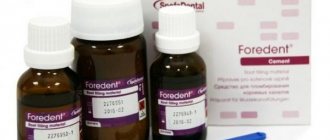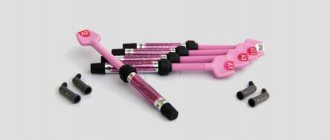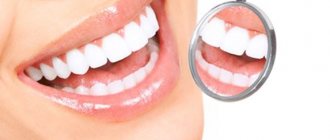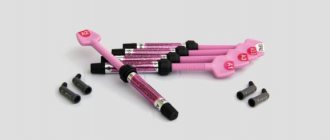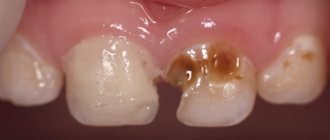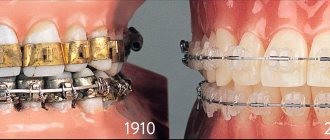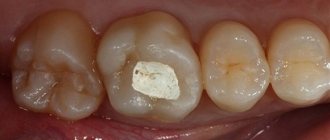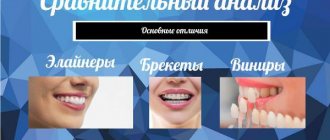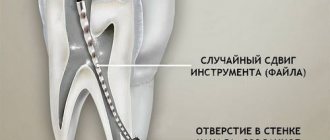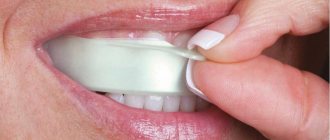A variety of modern techniques used for filling developed root canals differ significantly from each other, but are still foreseeable. For obturation of root canals, dentists are provided with a very large selection of materials, but there is no such confusion as when choosing a combination of solutions for root canal irrigation. At this stage of endodontic treatment, there are also no dangerous mutual effects between the materials used.
Gutta-percha
In fact, the most necessary material for filling root canals is undoubtedly gutta-percha, which is used in almost any filling method. This material has the elasticity of rubber and is by its nature a close relative. Gutta-percha is obtained by evaporating the milky juice of special varieties of gutta-percha tree. Gutta-percha was first used for filling root canals in 1867 by Bowman.
ISO-standardized tapered pins contain the following components:
- gutta-percha;
- zinc oxide - as a filler;
- barium sulfate - for radiopacity;
- waxes - to obtain the required consistency;
- dyes and small amounts of trace elements (Guldener, 1993; Hülsmann, 1993).
Gutta-percha points are most often used in combination with so-called sealers.
Sealers are pastes for filling root canals, which are mixed from two components and serve to fill the gap between the canal wall and the gutta-percha pin/pins. Sealers also fill small branches of the root canal and lateral tubules.
There are two options for applying paste to fill the canal:
- first, using a canal filler (lentulo), the sealer is introduced into the canal, and then a gutta-percha pin is inserted, and the sealer is pushed towards the canal walls;
- The gutta-percha point is coated with a small amount of sealer and then inserted into the canal, thereby pushing the sealer into the canal.
This is the “standard concept” of root canal filling, which has been used by dentists in everyday practice for many decades. Sealers are pastes for filling root canals, which are mixed from two components and serve to fill the gap between the canal wall and the gutta-percha pin.
In his dental clinic, the author also uses this effective and efficient method of filling root canals as part of the services covered by public health insurance: the sealer is inserted into the root canal on one (central) gutta-percha pin. The author has been using AH Plus material as a sealer for 7 years. This method of filling root canals is called the method of one (central) pin, or monopin. Currently, this method is most often used for endodontic treatment as part of services covered by public health insurance.
This method has some significant advantages: a ready-made conical gutta-percha pin, due to pressure, moves the sealer paste, previously introduced into the root canal (or introduced simultaneously with the pin), to the canal walls and distributes it over their entire surface. Most often, due to the pressure of the gutta-percha pin, the sealer paste also penetrates into the areas of the apical branches of the root canal. In many cases, at the root apex there is a branching of the main root canal, resembling a river delta.
However, in principle, as a result of mechanical treatment of the root canal, according to all the rules, only the main axial central root canal is developed. Most often, at the moment when a gutta-percha pin is inserted into the root canal, additional (lateral) tubules that are completely inaccessible for mechanical treatment are also filled with filling material, since the excess applied sealer under pressure inevitably penetrates laterally and apically (!), i.e. into in all possible directions.
However, this often leads to unwanted removal of the sealer paste beyond the physiological or even anatomical apical foramen. The question of the negative impact of this phenomenon remains controversial. For example, in Germany, the removal of filling material beyond the apical foramen is an indicator of insufficiently high-quality treatment, and American colleagues believe that it is the (insignificant) removal of filling material beyond the apical foramen that serves as a sign of a particularly successful root canal filling (puff).
As with many aspects of practical endodontics, unfortunately, there is no evidence-based medicine yet on the issue of the acceptable level of root canal filling. All conclusions are made purely empirically. A good confirmation of this is the way dentists treat the removal of filling material beyond the apical foramen.
Of course, whether negative consequences will be observed when the material is removed beyond the apical foramen depends on what material was used to fill the root canals and to what extent it was removed beyond the apex. Thus, slight removal of a biologically inert sealer beyond the apical foramen when used correctly is most likely safe. In Germany, removal of filling material beyond the apical foramen is an indicator of insufficiently high-quality treatment. But the removal in a larger volume beyond the apex of a non-resorbable filling material with supposed cytotoxic properties (for example, the previously frequently used material Diaket, Seefeld) most likely poses a danger. In this case, if there is a significant amount of material removed beyond the apex, it is subsequently necessary to perform an operation of resection of the root apex. It all depends on the situation in a particular clinical case, i.e., it should be taken into account whether the material removed beyond the apex has an irritating effect on the periapical tissues.
There are completely new methods of filling root canals, which use ONLY heated gutta-percha (without sealer). When using these methods, gutta-percha softens to such an extent that, without the additional use of a sealer, it can penetrate into all the necessary areas of the root canal. The result is a hermetic root filling with good adaptation to the walls of the root canal.
Such methods (for example, the Thermafil system) are very rational, and therefore can be used as part of “generally available endodontic treatment”. However, the questions about whether it is necessary to abandon the additional use of sealer and whether a sufficiently sealed root filling is obtained without a sealer have not yet been finally clarified. There is also no evidence-based medicine on this important issue.
When briefly listing the current methods of filling root canals using gutta-percha, it is necessary to mention the methods of lateral condensation and vertical condensation (according to Schilder). These labor-intensive methods are used, as a rule, as private medical services and mainly by dentists specializing in the field of endodontics.
The author believes that due to the large investment of time and money, these methods are difficult to use as “standard” within the framework of “generally available endodontic treatment.” However, as a compromise solution, “mixed” methods can be used.
Which endodontic filling material combats microbial films more effectively?
The accumulation of microbial complexes in the root canal complicates the process of tissue healing after endodontic intervention. To clean root canals from biofilm, mechanical treatment and irrigation are often not enough.
The study assessed the antimicrobial properties of 5 root canal sealing materials and found that two materials—Vitapex and 100% iodoform paste—were more effective at killing microbial biofilms than others.
“Iodoform paste without additives and Vitapex, which also contains iodoform, are better at destroying microbial biofilms. At the same time, Vitapex is suitable for filling the canals of temporary teeth,” says the author of the work, a graduate student at the Faculty of Dentistry of the Federal University of Pelotas, Katerina Janeke Pilovnik from Brazil.
The tortuous structure of root canals
The root canals of primary teeth have a tortuous anatomical structure. In addition, the treatment requires careful isolation of the area and interaction with young patients, so this procedure is considered labor intensive.
In addition, structural changes can occur as a result of root resorption, which in turn increases the risk of pathogenic cocci and bacilli entering the bloodstream. If the canals are not sufficiently cleansed of microbial complexes, the inflammatory process will continue, which will complicate the healing of the periapical tissues.
Mechanical treatment and rinsing are often not enough to clean the canals of baby teeth from attached bacteria. Researchers have suggested that the use of filling materials with antimicrobial action will contribute to more effective destruction of pathogenic microflora.
To do this, we conducted a comparative analysis of the effect of 5 materials for obstructing the root canals of temporary teeth on microbial biofilms in vitro; sterile water was taken as a control solution.
The materials studied included:
- Zinc Oxide Eugenol Cement (SS White Artigos Dentários)
- Paste containing calcium hydroxide and iodoform (Vitapex, Neodental International)
- A mixture of 1 gram calcium hydroxide polyethylene glycol paste (Calen, SS White) and 1 gram zinc oxide
- 100% calcium hydroxide paste
- 100% iodoform paste
The researchers cultured an anaerobic microbial biofilm of different bacterial species on 36 sterile hydroxyapatite disks for 21 days. They then placed a 0.1 gram layer of each of the 5 materials into each disk for 7 and 30 days.
Using a laser scanning microscope, images of 180 species of bacteria were obtained. Simultaneous two-channel imaging showed a red and green glow: living bacteria reflected green rays, and bacteria with destroyed membranes reflected red rays.
Scientists found a significant difference in the number of surviving microorganisms in all groups after 7 and 30 days. As it turned out, a mixture of Calen paste with zinc oxide and 100% calcium hydroxide paste had a less pronounced antimicrobial effect 30 days after the start of the experiment.
Percentage of microbial biofilms destroyed
| Material | 7 days | 30 days |
| Vitapex paste | 46% | 51% |
| 100% iodoform paste | 41% | 69% |
| Zinc oxide eugenol cement | 35% | 34% |
| 100% calcium hydroxide paste | 16% | 19% |
| Calen paste and zinc oxide | 9% | 27% |
| Sterile water (control solution) | 7% | 6% |
Role of iodoform
To evaluate the antimicrobial properties of iodoform and calcium hydroxide in other cements, such as Vitapex paste and Calen paste with zinc oxide, the scientists tested samples of pastes containing 100% of these substances. As the results showed, both 100% iodoform paste and Vitapex paste containing it performed equally well during the experiment.
“Based on the results of the current study and review of other studies, we hypothesize that the effectiveness of Vitapex paste is related to the activity of iodoform. Because, as can be seen, when using 100% iodoform, almost 70% of microbial complexes died.”
The scientists also noted that this is the first study to examine the possibility of using 100% iodoform paste as a material for root canal obstruction in primary teeth.
“The antimicrobial activity of restorative materials is important for successful endodontic treatment, however, it is not the only property of an ideal restorative material.”
Sealers
Pastes for filling root canals are usually self-hardening. They consist of two mixing components and have different chemical compositions.
The dental materials market offers a large number of sealers of the most varied composition from various competing manufacturers. Below the author provides a list of sealers currently used, and also mentions some materials that are no longer used.
Table No. 1. Sealers currently available on the market and their composition (in alphabetical order).
| 1. Acroseal (Septodont) | epoxy resin matrix containing calcium hydroxide |
| 2. AH 26, two versions (Dentsply) | matrix based on epoxy resin; composition options: with and without silver additives |
| 3. AH plus/AH plus Jet (Dentsply) | based on epoxy-amine polymers (AH plus Jet: automatic mixing system) |
| 4. Apexit Plus (Ivoclar Vivadent) | contains calcium hydroxide (base?) |
| 5. Endomethasone N (Septodont) | based on zinc oxide eugenol, currently free of formaldehyde |
| 6. Gangraena-Merz N (Merz Dental) | calcium hydroxide-based material that can be used for both temporary and permanent filling of root canals |
| 7. Hermetic (lege artis) | cement based on zinc oxide-eugenol for permanent filling of root canals |
| 8. Ledermix MTA | MTA cement for endodontic treatment of perforations or retrograde filling of root canals, as well as for apexification in the treatment of teeth with incomplete root formation |
| 9. N2 Endodontic Cement (Hager & Werken) | based on zinc oxide eugenol, with a reduced (!) formaldehyde content compared to the previous version of the composition (but still contains formaldehyde) |
| 10. Perma Evolution (Becht) | polymer based on epoxy resins |
| 11. RealSeal (Sybron Endo / Kerr) | thermoplastic synthetic polymer with bioactive (?) and radiopaque glass fillers |
| 12. rocanal r2 permanent vital (la Maison Dentaire) | cement based on zinc oxide-eugenol for permanent filling of root canals after vital pulp extirpation |
| 13. rocanal r3 permanent gangrene (la Maison Dentaire) | cement based on zinc oxide eugenol for permanent filling of root canals after treatment of gangrenous pulpitis, contains 5% orthophenylphenol (!) and 0.5% nitrofurazone (?) |
| 14. Sealapex (Sybron Endo / Kerr) | polymer, contains calcium hydroxide |
| 15. 2Seal (VDW) | based on epoxy-amine resin |
| 16. GuttaFlow (Roeko) | system for filling canals with cold gutta-percha in combination with a central gutta-percha pin (Master-Point) |
| 17. RoekoSeal (roeko company) | based on polymethylsiloxane (silicone), expands slightly during curing (0.2%) |
The list, for example, mentions material N 2 (, Sargenti), containing toxic formaldehyde. Currently, the material is no longer used in Germany. The list also includes the still widely popular material Endomethasone N (Septodont). Currently, the composition of the material has been slightly changed compared to the previously used original Endomethasone material. In the Endomethasone N material, the content of anti-inflammatory drug components (corticoids, diiodothymol) is significantly lower. These components in sealers have been subject to intense criticism for several decades in student textbooks and scientific papers.
Pastes for filling root canals are usually self-hardening. They consist of two mixing components and have different chemical compositions. The list of materials for filling root canals also includes hardening two-component sealers based on polymers (the polyketone-based material Diaket is no longer produced). The dentist has at his disposal various polymer-based sealer systems (AH plus, Sealapex, Apexit, etc.), as well as silicone-based systems (Roeko Seal). Such materials are highly elastic and have a relatively low final hardness. Due to this property, root fillings made from such materials are easily removed during endodontic revision (retreatment).
It is surprising that the nature of the chemical composition of sealers is completely different. There is no evidence-based medicine yet on whether calcium hydroxide (Ca(OH)2) additives are advisable in such materials.
According to the author, the “favorite” material of German dentists in clinics and dental offices is currently AH plus (Dentsply). Many scientific articles are devoted to this material. AH plus consists of two paste-like components mixed in equal parts and is very easy to use. The material replaced the previously widely used sealer AH 26 several years ago. The sealer AH 26 was developed back in 1954 (Schroeder), it released a small amount of formaldehyde (!) (Schäfer, Hickel, 2000). For this reason, the material in its original composition is no longer used.
However, this drug has its advantages and its adherents. Modern material AH 26 supposedly does not contain formaldehyde. And the currently used N2 Endodontic Cement material based on zinc oxide eugenol still (!) contains formaldehyde, but in a “reduced” concentration compared to the previously used similar material.
It is the use of formaldehyde, as well as chlorophenol-camphor-menthol (ChKM) drugs, that is the subject of debate in university circles. All eminent university teachers do not recommend the use of these drugs.
However, at present there is a time of “renaissance” for the Jodoform-Paste material, which contains the drug chlorophenol-camphor-menthol and has long been considered obsolete. According to modern publications, this material is again recommended for use in pediatric dentistry (endodontic treatment of baby teeth).
New materials based on glass ionomers and salicylates with calcium hydroxide additives, as well as MTA (mineral trioxide aggregate) cement, are currently undergoing the test of time in endodontics.
It is noteworthy that there is no single concept regarding the composition of a good “standard” sealer. Each manufacturer offers its own composition options.
There is no single concept regarding the composition of a good sealer. Each manufacturer offers its own option. Rubber-like, highly elastic preparations based on silicones are also advertised and used as materials for filling root canals. For example, the fairly commonly used material Roeko Seal has the property of expanding in volume by approximately 0.2% when cured. This property of the material should ensure a particularly good fit of the root filling to the walls of the root canal.
On the other hand, silicones have the ability to absorb moisture in small quantities. Are root fillings made from silicone-based materials really impervious to bacteria? The author still has serious doubts about this.
Thus, the variety of paste sealers offered for filling root canals is very large. And not only because they are represented on the market by a large number of competing manufacturers, but also due to the diversity of the composition of materials.
Endodontics is still a broad field of experimentation, especially in the field of root canal fillings.
Materials for obturation of the canals of temporary teeth
Filling dental roots in children has certain nuances. The main feature of permanent obturation of temporary teeth is the need to use materials that can be absorbed along with the root. Most often they are represented by plastic pastes:
- Zinc oxide eugenol. The most common material for filling the canals of baby teeth. It has antibacterial and anti-inflammatory properties, minimal side effects and high clinical effectiveness. The paste is very easy to use due to its plasticity and undemanding nature to dry teeth.
- Iodoform. Such products have good hygroscopicity, low toxicity, excellent anti-inflammatory activity and a powerful antiseptic effect. It quickly dissolves along with the root, does not irritate the periodontium, and is easily inserted and removed from the canal cavity.
- Based on calcium hydroxide. It is used quite rarely for obturation of temporary teeth. At the same time, the material is very easy to use, has excellent biocompatibility and minimal toxicity, and has a strong antibacterial effect. Perfectly stimulates the processes of apexification and apexogenesis.
If necessary, preparations for obturation of primary teeth can be combined with each other and with other substances to improve certain properties. The drugs are administered using a syringe with disposable nozzles, in which the material is supplied to the market. It is also possible to fill intradental cavities with filling compounds using special endodontic instruments.
Other obturation methods
A unique method of filling root canals is the so-called Russian Red, which was previously used in the countries of the Eastern Bloc, including in the former GDR. This filling material is a resin-based polymer in nature. Once cured in the channel, the material turns red and becomes incredibly hard. It is very difficult to remove from the root canal during root canal revision (only with the help of aggressive solvents). However, after filling the root canals with this material, a revision has to be carried out quite rarely, since teeth with these old root fillings are most often miraculously completely “cured” without causing complaints. The author cannot give an explanation for this phenomenon.
After Russian Red root canal filling, teeth are miraculously completely “cured.” With other exotic methods of filling root canals, completely different paste-like sealers without gutta-percha are used. Although these methods save time, such root fillings are less airtight. Therefore, such methods are generally not recommended, even within the framework of “generally available endodontic treatment.” There is still no evidence-based medicine for these methods.
At the beginning of the article, two very labor-intensive methods of root canal filling were already mentioned, which differ significantly from each other: lateral condensation (compaction) of gutta-percha using several pins and vertical condensation of heated gutta-percha. These treatment methods, as well as their various modifications/mixed variants, belong to private dental services in the field of endodontics and are outside the scope of public health insurance. Their use requires a lot of time and the purchase of expensive devices, so they can be classified as expensive private dental services, most often provided in dental offices specializing in endodontics, as well as in university clinics.
Purpose of root canal filling
The effectiveness of therapeutic measures for diseases such as purulent abscess, periodontitis, pulpitis and other equally dangerous pathologies of the dental system depends on how correctly the specialist carries out the treatment and filling of root canals.
In their work, endodontists at our Research Center clinics in Moscow use high-precision endodontic microscopes of the latest modification from leading manufacturers of medical equipment, which allow saving teeth even in the most seemingly hopeless cases.
Lateral condensation (compaction)
With this method, sealer is first introduced into the root canal using an instrument, or the main (first) gutta-percha pin (Master Point) is wrapped in sealer and inserted into the root canal. Then, additional gutta-percha pins of a smaller ISO size (usually ISO size 25) are inserted next to the central main pin. To provide space for additional tapered pins, a special compaction tool (spreader) is used. The spreader is introduced into the root canal with some pressure and pushes the filling material already present in the canal to the opposite walls, and then removed from the root canal. After this, another additional gutta-percha pin is inserted into the root canal.
With this method, five, six or even more additional gutta-percha points can be inserted into the root canal. After completing the procedure for inserting the pins, before cutting off their protruding ends, such a root filling looks from the outside like a “bouquet” of flower stems without leaves.
The advantage of using this method is the ability to select pins of different sizes for the root filling consisting of several parts of the “gutta-percha core” and individually fit them in the root canal. In this way, it is possible to obtain a reliable and hermetic root filling, with a tight marginal seal, even in areas of the root canal that do not have a round cross-section.
In practice, the dentist almost never encounters the round cross-section of the canal, and the lateral condensation method is considered the “gold standard” for filling root canals. The actual clinical situation often looks very different from the idealized phantom root canal filling on plexiglass blocks that is taught in endodontic workshops. In practice, a dentist is faced with any shape of the canal cross-section, but not a round one. It is precisely because of this discrepancy between theory and practice that in some textbooks, including modern ones, the lateral condensation method is considered the “gold standard” for filling root canals, if we do not take into account another method (vertical condensation), which will be presented in the final parts of the article.
When carrying out endodontic treatment within the framework of public health insurance, a mixed method of filling root canals can be used: at least one very wide root canal or a canal with an oval cross-section is filled with several gutta-percha points using the labor-intensive lateral condensation technique, and narrower root canals with only one central pin in combination with sealer. The author has been using this “mixed” method for several decades.
Vertical condensation
This very labor-intensive method of filling root canals is based on the use of hot (heated) gutta-percha. First, the apical part of the root canal is filled with heated and largely softened or almost liquid gutta-percha, and then compacted by machine (condensed).
This part of the vertically condensed gutta-percha root filling is called Downpack according to the English terminology currently used in Germany.
For compaction, heated instruments are used to keep the gutta-percha in a softened state until it is completely compacted. To condense gutta-percha, among many other systems, rotating instruments are used, which, due to the release of heat during friction, help to soften part of the Downpack root filling.
The part of a root filling made of vertically condensed gutta-percha is called a Downpack according to the English terminology currently used in Germany. The root canal filling technique, first described by Schilder in 1967, is very labor-intensive because it requires special devices for heating and condensing gutta-percha. In addition, tapered Master Points are required, which must exactly match the taper and volume of the root canal or the last instrument used to develop the root canal. Then, before inserting into the root canal, the gutta-percha pins are shortened at the apex by 0.5-1 mm so that if there is significant compaction (condensation) in the canal, the material is not removed beyond the apical opening.
In addition, according to the Schilder technique, the Master Point is first fitted into the root canal, after which a control radiograph is taken, which verifies the correct seating of the pin in the canal. Only after this is its final condensation in the root canal.
After filling the apical third, the middle and upper parts of the root canal (Backfill) are also filled with heated gutta-percha, which is injected directly into the canal using a syringe. To do this, gutta-percha is preheated in a special device (oven) to a liquid state. This labor-intensive method results in root fillings that adhere very well to the walls of the root canal.
Due to their almost perfect tightness, such seals effectively prevent the penetration of bacteria into it.
This is what the technique of vertical condensation of gutta-percha looks like in general. However, there are various modifications of Schilder's original method. Some dentists create a new “ideology” from every new little thing they come up with and do not allow the slightest deviation from “their” concept. The choice of one or another method of canal filling depends to a certain extent on the beliefs of the dentist.
Dental manufacturing companies have been very successful in making money from endless variations of the vertical condensation method, selling pluggers and ovens for preheating gutta-percha, as well as “special gutta-percha.”
Cases when the cost of root canal treatment cannot be low
The cost of root canal filling in our clinics is higher than the average price in Moscow. But it fully corresponds to the quality of the services provided and depends on factors such as:
- Status of the dental clinic - we are leaders in the ranking of the best clinics in Russia and Moscow for four years now.
- Qualification of specialists - our doctors have been the best in Russia and Moscow since 2016. Many of them are doctors or candidates for doctor of medical sciences with extensive experience in medical practice.
- The use of innovative technologies and unique equipment from German and Swiss manufacturers of dental equipment in the process of treatment and filling of teeth - an endodontic microscope, the BeeFill Pack system and the highest quality materials from Switzerland.
All this together allows us to provide our patients with highly qualified care at the highest level of performance, and therefore cannot be cheap.
Injection methods, Ultrafil, Thermafil
Recently, the method of introducing heated (liquid) gutta-percha using special syringe systems directly into the canal (Obtura system) has also begun to be used. In this case, gutta-percha, heated to a temperature of 160-200 ° C (!), is introduced directly into the root canal using a special injection needle (cannula) of sizes 40 and 60 according to ISO standards.
With this method of canal filling, there is no need to use a sealer. However, the high temperatures used can, in direct contact with tissues, lead to burn damage to surrounding tissues (at the root apex?).
The dentist also has some other systems at his disposal, in which only slightly heated gutta-percha is used, rather than heated to a molten state (Ultrafil, Thermafil). With this method of application, gutta-percha softens a little, after which it is very easy to apply it to those parts of the root canal of the tooth that are not round in cross section.
Thermafil and Thermafil-Plus systems are widely used. This method uses plastic pins coated with gutta-percha. Pin sizes are standardized according to ISO standards. Such a pin is heated for a short time in a small electric oven and, during a short plastic phase, the heated gutta-percha is inserted into the root canal. The protruding excess pin is cut off. But even with this method, accidental pushing of heated gutta-percha into the apical region is possible.
The method of filling root canals using the Thermafil system is quite economical, therefore, in some dental offices aimed at a certain social contingent, patients do not need to pay an additional amount: the treatment is carried out within the framework of state health insurance.
Charging additional fees for endodontic treatment as part of “cash” services from patients insured by public health insurance funds can sometimes be quite problematic. So, unfortunately, the question once again arises: are innovations like the Thermafil system applicable in everyday dental care, if this is associated with even minor additional costs?
The “Central Pin Technique” and Thermafil or Ultrafil systems are economical, effective and realistically applicable in the provision of services within the framework of public health insurance. A dental office that primarily serves patients under public health insurance is faced with a difficult dilemma. And in such a situation, it is the Thermafil system that could find its application within the framework of “generally available endodontic treatment”. However, the question of whether with this method it is necessary to additionally use sealers or whether heated gutta-percha ensures sufficient tightness of the root filling is still being discussed. Saving time does not always benefit the patient.
In dental offices, mainly serving patients under public health insurance, the most often used, described in detail at the beginning of the article, is the very economical “central pin method” in combination with two-component paste sealers.
The author came to these conclusions after numerous discussions on this issue with colleagues during numerous master classes and meetings of quality control groups.
As mentioned above, this standard method of root canal obturation, if necessary, can be easily modified by using additional gutta-percha pins of the “lateral condensation” type, for example in the distal root canals of molars that are very wide or do not have a round cross-section, as well as for filling “large caliber” root canals in incisors and canines.
The author successfully uses the central pin method, as well as the method of “partial” lateral condensation, in his practice and has obtained good treatment results when filling root canals within the framework of state health insurance services (more than 4000 root fillings).
The author uses AH Plus sealer to fill root canals. The only question that remains is which of the many described methods can be considered standard for endodontic treatment within the framework of public health insurance.
The author is convinced that such a method could be the “central pin technique” in combination with a two-component sealer (containing calcium hydroxide), as well as the use of Thermafil or Ultrafil systems. These methods are economical, effective and therefore really applicable in the provision of services within the framework of public health insurance.
This topic should be discussed in professional circles in order to resolve the question of how endodontic treatment can be included in the list of services provided under public health insurance. And it is possible that, based on methods confirmed by evidence-based medicine, such endodontic treatment can be carried out at a much higher quality level. This is certainly doable.
Canal filling using E&Q Plus
This is a sealing of the dental canal with hot gutta-percha, which includes an injection gun with a special heating tip and a control unit. The equipment included in the system allows you to use three filling techniques at once:
- vertical compaction of preheated material;
- gutta-percha injection;
- a combination of the above techniques.
The standard procedure for filling root passages using this system includes the following steps:
- introduction of a sealer into the canal and application of a gutta-percha pin;
- condensation of the pin in the apical direction using a hot electric plugger;
- cutting off the coronal part of the gutta-percha pin;
- filling the root canal with heated gutta-percha using a special obturator-gun;
- Compacting gutta-percha using a cold plugger system.
There are other methods of sealing root canals, but they are used much less frequently than those described above. One way or another, a competent approach to this procedure allows you to quickly and painlessly fill the root canals, returning the teeth not only to their original functionality, but also to their aesthetic properties.
You just have to want it
For specialists in this case, the field of activity remains endodontic treatment in particularly complex root canal anatomy, as well as in particularly complex clinical situations, and for “particularly gifted” specialists - perhaps complex cases of root canal revision.
There is enough work for everyone. In any case, this would benefit “general-profile” therapeutic dentistry.
The article was provided by the magazine of the official publication of the Association of Dentists of Lower Saxony (Germany) NZB - Niedersächsisches Zahnärzteblatt (No. 6, 2011, pp. 31-34).
Translation by Inna Bichegkueva.
